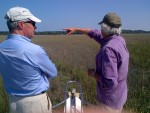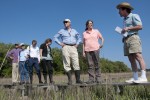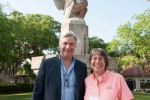United States Sen. Sheldon Whitehouse of Rhode Island visited the Georgia Coastal Ecosystems (GCE) Long Term Ecological Research (LTER) Project this past April as part of his “Climate Change Road Trip”, a multi-state tour along the southeastern coast. Whitehouse toured GCE field sites along Sapelo Island’s salt marshes and tidal creeks and then met with scientists, coastal managers, and community leaders at the University of Georgia (UGA) Marine Institute.
Whitehouse is a member of the Senate Environment and Public Works Committee and chairman of the Subcommittee on Clean Air and Nuclear Safety, and was on a swing through the region to learn about ongoing research to evaluate rising sea levels and other climate-related issues. In comparison to the northeast, the southeast has more extensive salt marshes and more tidal freshwater habitat, but fewer cities. This changes the vulnerability as well as the adaptation options.
GCE scientists participating in the event included Merryl Alber, Charles Hopkinson, and Clark Alexander (all at UGA), as well as Chris Craft and graduate student Ellen Herbert (Indiana University). Partners from the Sapelo Island National Research Reserve, the Georgia Department of Natural Resources Coastal Management Program, Georgia Sea Grant and The Nature Conservancy also described their work on various aspects of coastal climate change. Projects highlighted ranged from a flux tower set up by the GCE project to continuously measure carbon exchange between a salt marsh and the atmosphere, to a web-based tool supported by the Governor’s South Atlantic Alliance that can be used to evaluate the potential vulnerability of southeastern coastal communities to hazards such as hurricanes.
“I’ll do a better job convincing Congress to do something about climate change if I’m talking about their communities,” said Whitehouse, who also co-Chairs the Senate Climate Action Task Force. He specifically mentioned the visit as part of a speech the following week on the Senate floor,
“Down the coast, I visited the University of Georgia’s Marine Institute at Sapelo Island…Here I learned how they are measuring ’blue carbon,’ the amount of carbon stored in the salt marsh, as part of National Science Foundation’s Long Term Ecological Research Program. Salt marshes are huge carbon sinks, but the carbon stored there may be returned to the atmosphere if salt marshes succumb to sea-level rise with nowhere to migrate. We also discussed how the intruding saltwater is changing local marsh ecosystems and jeopardizing fresh water supply.”
“This was a wonderful opportunity to showcase the important research being done on Georgia’s coast,” said David Lee, UGA vice president for research. “It was really rewarding for me to have Sen. Whitehouse and our other guests see the good work being done here.”

 Enlarge this image
Enlarge this image

